To measure fragrance oil potency accurately, you'll need a digital scale with two decimal places and glass containers for precise weighing. Start with standard concentrations: Parfum (20-30%), Eau de Parfum (15-20%), or Eau de Toilette (5-15%). Calculate your dilution ratio by dividing fragrance oil weight by total mixture volume, then multiply by 100 for percentage. Always wear safety gear and maintain proper ventilation. Understanding these basics sets the foundation for creating professional-quality perfumes.
Understanding Fragrance Oil Concentrations
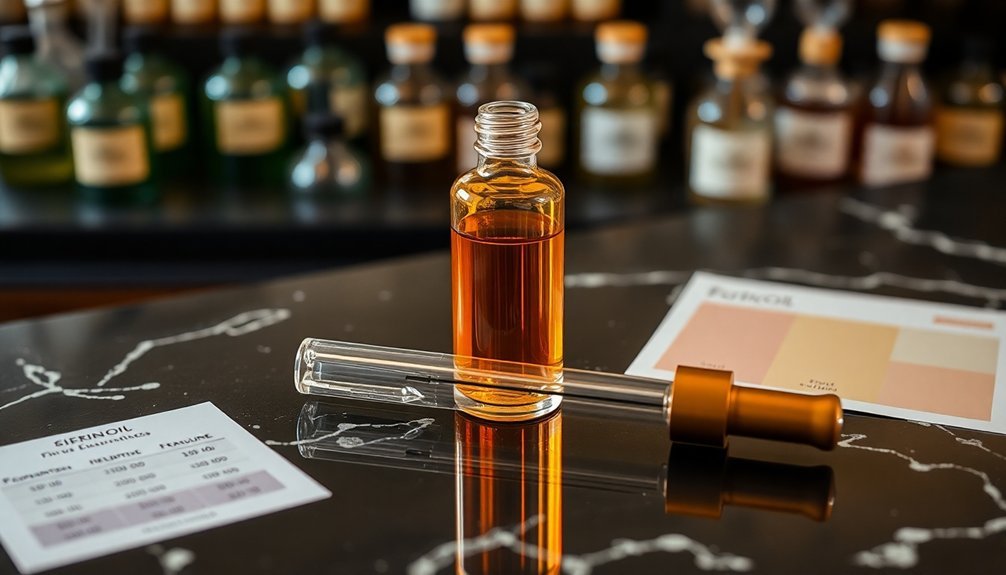
When it comes to creating your own perfume, understanding fragrance oil concentrations is essential for achieving the desired scent impact.
You'll need to choose between three main concentrations: perfume (20-30%), eau de parfum (15-20%), and eau de toilette (5-15%).
Make sure you're weighing your fragrance oil rather than measuring by volume, as density variations can affect your final product's consistency.
Precision matters – always weigh fragrance oils instead of volume measuring to maintain consistent results in your perfume formulations.
The concentration you select will determine both the intensity and longevity of your scent. Higher concentrations create more potent and longer-lasting fragrances, with true perfume offering the most powerful experience.
Remember that proper dilution with carriers like alcohol or oil will influence your scent's profile, so you'll need to balance these elements carefully to create a harmonious blend that matches your vision.
Essential Tools for Measuring Oil Potency
Accurate measurement of fragrance oils starts with the right tools.
You'll need a digital scale that measures to at least two decimal places to guarantee precise dilutions in your perfume making process. This level of accuracy is non-negotiable for achieving consistent results.
A glass pitcher or container is your next essential tool.
It's vital to keep your fragrance materials separate from other kitchen items to prevent cross-contamination. When you're ready to measure, place your glass container on the scale and don't forget to tare it before adding your oils.
Always weigh your fragrance oils rather than measuring by volume, as oils can have different densities. This weight-based approach will help you maintain consistent potency and achieve the exact scent profile you're aiming for in your final product.
Standard Perfume Strength Classifications
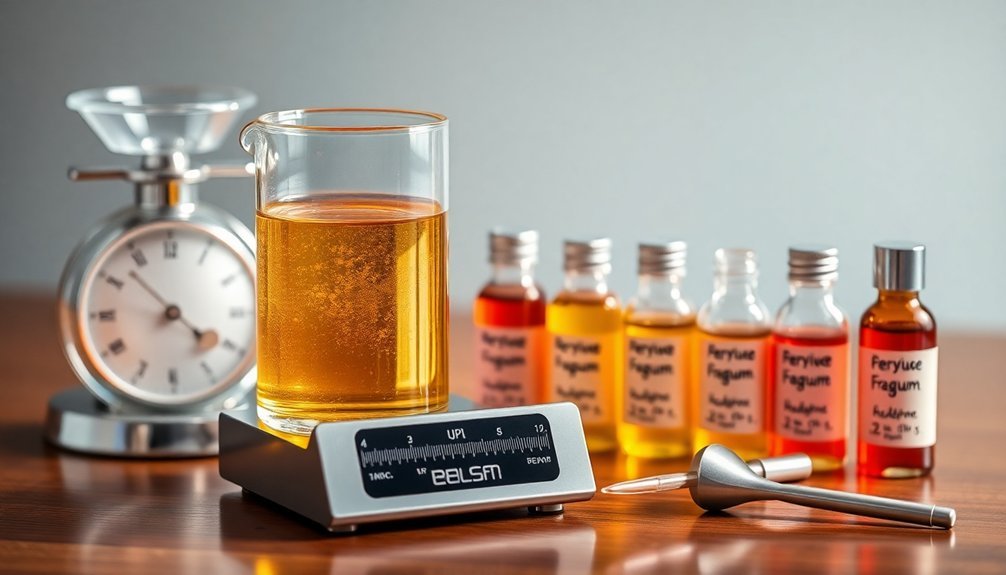
Perfume strengths follow a standardized classification system that ranges from the most concentrated to the lightest formulations.
You'll find Parfum at the top tier, containing 20-30% fragrance oil, which gives you the longest-lasting scent experience on your skin.
For special occasions and evening events, you'll want to reach for Eau de Parfum, with its 15-20% concentration that provides robust staying power.
If you're heading to work or running daily errands, Eau de Toilette's 5-15% blend offers a perfect balance of presence without overwhelming intensity.
When you need a subtle touch, Eau de Cologne's lighter 2-5% concentration works well.
Understanding these classifications helps you select the right fragrance concentration for your specific needs and occasions.
Calculating Dilution Ratios
Understanding fragrance dilution ratios starts with mastering a simple mathematical formula. You'll need to divide the amount of fragrance oil by the total volume of your mixture, then multiply by 100 to determine the concentration percentage.
Let's say you want to create a 10% fragrance blend in a 100ml mixture. You'll need 10ml of fragrance oil combined with 90ml of your base.
While this calculation seems straightforward, it's essential to measure your fragrance oil by weight using a digital scale, as volume measurements can be unreliable due to density variations.
Don't hesitate to experiment with different concentrations to find your perfect blend. Remember that lower ratios will give you a lighter scent, while higher concentrations will create a more intense fragrance experience.
Basic Safety Protocols for Oil Handling
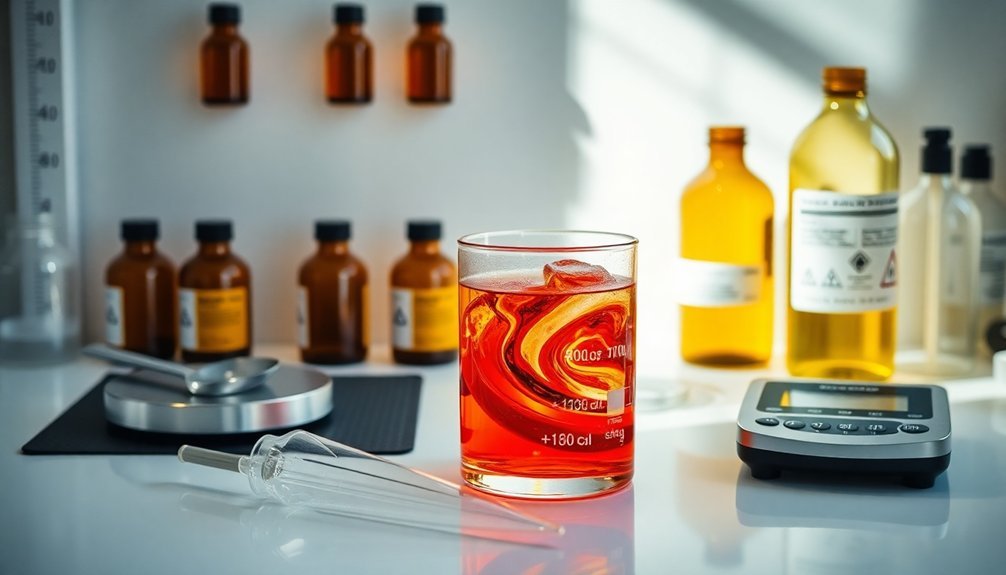
When working with fragrance oils, your safety should always come first. You'll need to protect yourself by wearing gloves and safety goggles to shield your skin and eyes from potential irritants.
Make certain you're working in a space with proper ventilation to avoid inhaling concentrated fumes.
Store your oils correctly to maintain their quality and prevent accidents. Keep them in a cool, dry area away from sunlight, and always place them where children and pets can't reach them.
When selecting containers for mixing and storage, avoid plastic materials that might contaminate your oils through chemical leaching. Instead, opt for non-reactive containers that'll preserve the integrity of your fragrances.
These simple precautions will help guarantee a safe and successful perfume-making experience.
Digital Scale Calibration Methods
Accurate measurements form the foundation of successful perfume creation, much like proper safety protocols protect you during the process.
To achieve precision in your fragrance formulations, you'll need to properly calibrate your digital scale.
Start by placing your scale on a completely flat, stable surface. Before measuring your oils, test the scale's accuracy using a calibration weight or coin with a known mass. If you notice any discrepancies, you'll need to adjust the scale's settings to match the known weight.
When switching between measurement units, such as from ounces to milliliters, perform a new calibration to maintain consistency.
Always check your manufacturer's manual for specific calibration instructions and recommended weights. Regular calibration checks will guarantee your perfume formulations remain precise and repeatable.
Temperature Effects on Oil Measurement
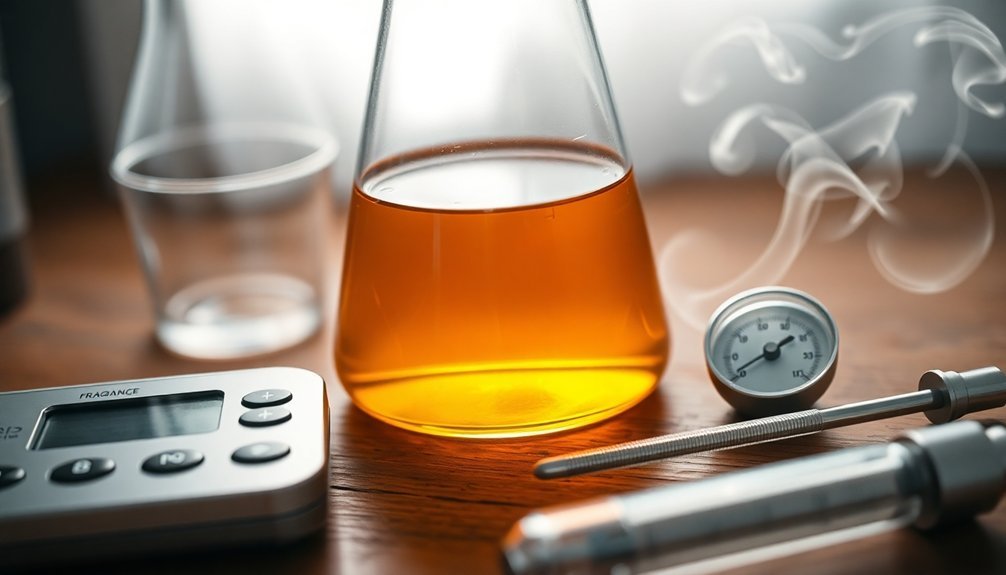
Temperature plays an essential role in how fragrance oils behave during measurement. When you're working with fragrance oils, it's vital to understand that their density changes with temperature fluctuations.
If you measure oils at varying temperatures, you'll get inconsistent results that can affect your final dilution's potency. To guarantee accurate measurements, you'll want to work with oils at room temperature, between 20-25°C (68-77°F).
Don't rush the process by measuring oils that are too hot or cold. Higher temperatures make oils more fluid, while cooling increases their viscosity, making them harder to pour precisely.
Before you begin measuring, let your fragrance oils naturally adjust to room temperature. This step prevents measurement errors caused by thermal expansion or contraction, helping you achieve the exact potency you're aiming for.
Common Measurement Conversions
You'll find that mastering volume-to-weight conversions is essential when working with fragrance oils, as 1 fluid ounce equals 29.57 milliliters while 1 weight ounce equals 28.35 grams.
For accurate measurements, you'll want to consult metric-imperial conversion tables, especially since different oils have varying densities that can affect your final calculations.
Your perfume formulations will be more precise when you use weight measurements rather than volume, making a quality scale an important tool for consistent results.
Volume to Weight Ratios
Understanding volume-to-weight ratios is essential when working with fragrance oils, as their densities typically range from 0.8 to 1.0 grams per milliliter.
You'll need this knowledge to accurately convert your measurements from volume to weight. To calculate the weight of your fragrance oil, multiply its volume in milliliters by the oil's specific density. For instance, if you're using an oil with a density of 0.9 g/mL, 10 mL will weigh 9 grams.
When you're working with larger quantities measured in fluid ounces, remember that one fluid ounce equals 29.57 milliliters.
Be sure to check your specific fragrance oil's density before making calculations, as variations between different oils can greatly impact your measurements' accuracy. This attention to detail will guarantee your dilutions are precise.
Metric-Imperial Measurement Tables
Mastering both metric and imperial measurements is vital for precise perfume dilution. You'll need to convert between these systems frequently when working with fragrance oils, as recipes often mix both measurement types.
Understanding that one fluid ounce equals 29.57 milliliters gives you a solid foundation for accurate conversions.
For everyday perfume creation, remember these important conversions:
- 1 teaspoon = 4.93 milliliters (perfect for small-batch calculations)
- 1 cup = 8 fluid ounces (helps when scaling up formulations)
- 1 fluid ounce = 29.57 milliliters (the basic unit for most conversions)
When converting ounces to grams, you'll need to factor in your specific fragrance oil's density, as this varies between different oils.
Keep these measurements handy to guarantee your formulations remain consistent and precise.
Professional Dilution Techniques
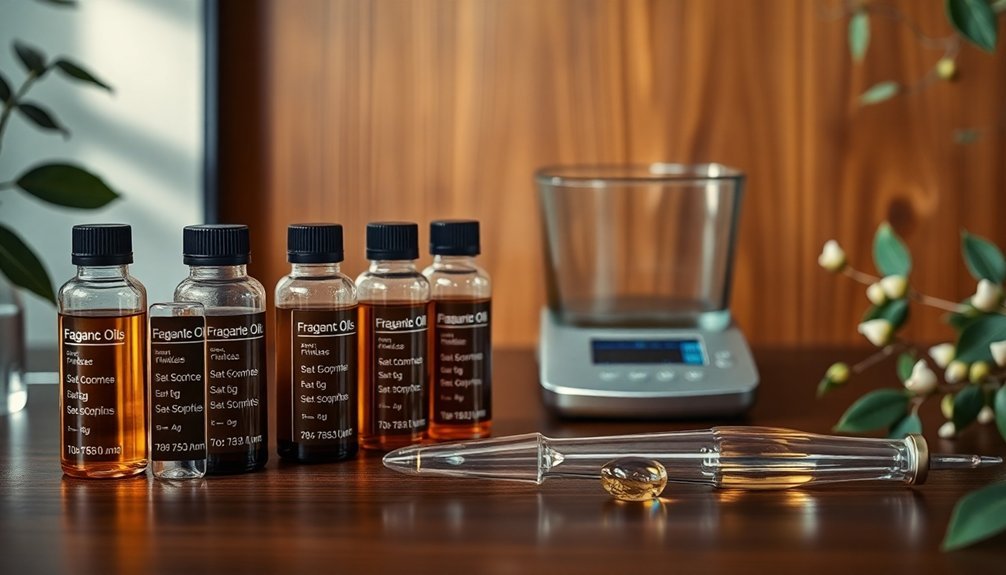
Professional fragrance dilution requires meticulous attention to detail and precise measurements for consistent, high-quality results.
You'll need to use a digital scale to weigh your fragrance oils accurately, as volume measurements aren't reliable due to varying oil densities.
When creating your perfume, stick to established ratios between 10% and 30% fragrance oil, depending on your desired strength.
You'll want to carefully select your base materials, whether alcohol or carrier oils, as they'll impact both the scent profile and how quickly the fragrance evaporates.
Always document your exact measurements and ratios in detail.
You'll find this record-keeping invaluable when you need to replicate or adjust your formulations later.
Remember that each fragrance oil has unique properties, so maintaining precision in your dilution process is key to achieving professional results.
Quality Control in Oil Measurement
Accurate oil measurement stands at the heart of successful perfume creation. You'll need to invest in a digital scale with at least two decimal places to guarantee precise measurements across your fragrance batches.
Since fragrance oils vary in density, weighing them rather than measuring by volume will give you more reliable results.
For ideal quality control in your measurements:
- Use dedicated glass containers for your fragrance oils to prevent cross-contamination and maintain the integrity of your scents.
- Regularly calibrate your measuring equipment, including scales and containers, to maintain accuracy standards.
- Document each measurement precisely, as even small variations can greatly impact your final product's potency.
Remember to keep your measuring tools clean and properly stored between uses to guarantee consistent, professional results in your perfume creation process.
Batch Recording and Documentation
Proper batch documentation serves as your perfume-making roadmap, helping you track every detail of your fragrance dilutions.
You'll need to record the specific fragrance oil type, its density, and precise measurements to guarantee consistent results in future batches.
Create a standardized format that includes essential information like dates, batch numbers, and any variations in your process.
You'll find this systematic approach invaluable when scaling up production or troubleshooting issues.
Your documentation should be clear enough that you can replicate each batch perfectly months later.
Don't forget to regularly update your records when you switch fragrance oil suppliers or adjust formulations.
These changes can greatly impact your dilution ratios and final scent profiles.
Keep your batch records organized and easily accessible for quick reference during future perfume-making sessions.
Troubleshooting Concentration Issues
When you're experiencing concentration problems in your perfume blend, start by checking the ratios between your fragrance oils and carrier ingredients to spot any obvious imbalances.
You'll need to adjust strong fragrances by carefully diluting them with carrier oils or alcohol, while weak scents require a measured increase in fragrance oil concentration.
Testing your adjustments on scent strips will help you confirm if you've achieved the right balance before finalizing your formula.
Identifying Imbalanced Oil Ratios
Creating balanced oil ratios remains essential for achieving the perfect fragrance, yet even experienced perfumers can encounter concentration issues in their formulations.
You'll know your blend has ratio problems when the scent feels flat or lacks proper depth. To maintain consistency and achieve ideal results, follow the standard 30:50:20 ratio for top, middle, and base notes in your perfume blends.
- Test your fragrance at multiple dilution stages to catch concentration issues early.
- Document all measurements and adjustments to track recurring imbalances.
- Pay attention to whether your scent is too weak or overpowering, as this indicates improper ratios.
Fixing Dilution Strength Issues
Successful perfume creation hinges on achieving the right dilution strength, which directly impacts how your fragrance performs on the skin.
If you're finding your scent too weak, you'll want to increase your fragrance oil percentage to 15-30% for eau de parfum strength. Conversely, if your blend is too potent, dilute it with carrier oil while maintaining the scent's character.
Keep track of your specific density measurements and record all adjustments you make. This documentation guarantees you can replicate successful formulations in future batches.
Remember that patience is key – let your adjusted mixture age for several days, as the scent profile often develops and stabilizes during this time.
Through careful measurement and systematic adjustment, you'll master the art of achieving the perfect fragrance concentration.
Frequently Asked Questions
How Much Should Fragrance Oil Be Diluted?
You'll need to dilute fragrance oils differently based on your product: 20% for perfumes, 6-10% for candles, 10-15% for room sprays, and 2-5% for skincare items. Always consider the oil's density when mixing.
What Is the 30/50/20 Rule for Perfume?
The 30/50/20 rule guides you in blending perfumes: use 30% top notes for initial impact, 50% middle notes for the main scent body, and 20% base notes for lasting depth in your fragrance.
How Do You Measure Fragrance Oil for Perfume?
You'll need a digital scale with two decimal places accuracy. Place your container on it, tare to zero, then weigh your fragrance oil directly. Don't measure by volume since oil densities vary.
What Is the Ratio of Fragrance Oil to Perfumers Alcohol?
You'll typically want to use a 20:80 ratio of fragrance oil to perfumer's alcohol for standard perfumes. If you're seeking a stronger scent, you can increase it to 30:70 for more intense results.
In Summary
You'll find that mastering fragrance oil dilution takes practice and careful attention to detail. Keep detailed records of your ratios, always follow safety protocols, and don't hesitate to test multiple concentrations until you achieve your desired results. By maintaining consistent measurement techniques and proper documentation, you're setting yourself up for reliable, reproducible fragrance formulations every time you create.
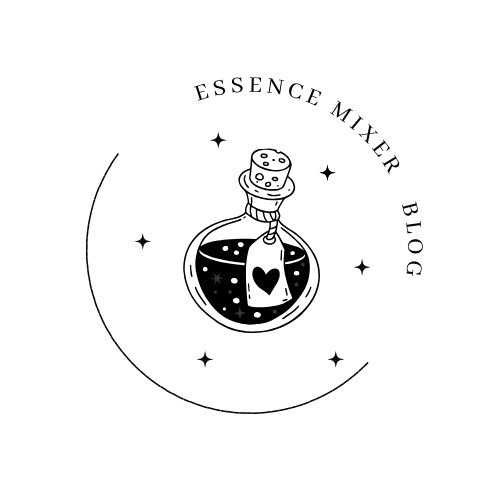
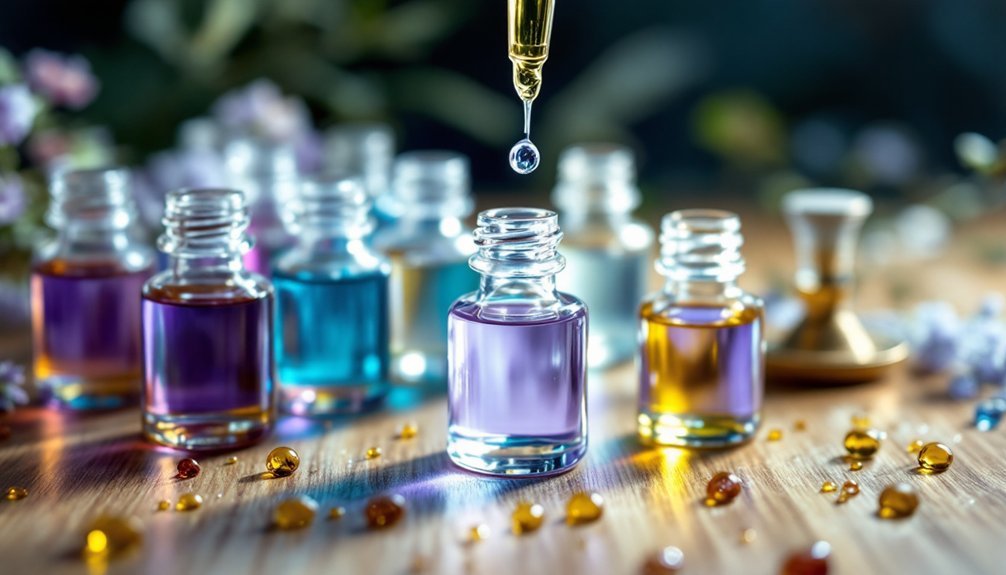
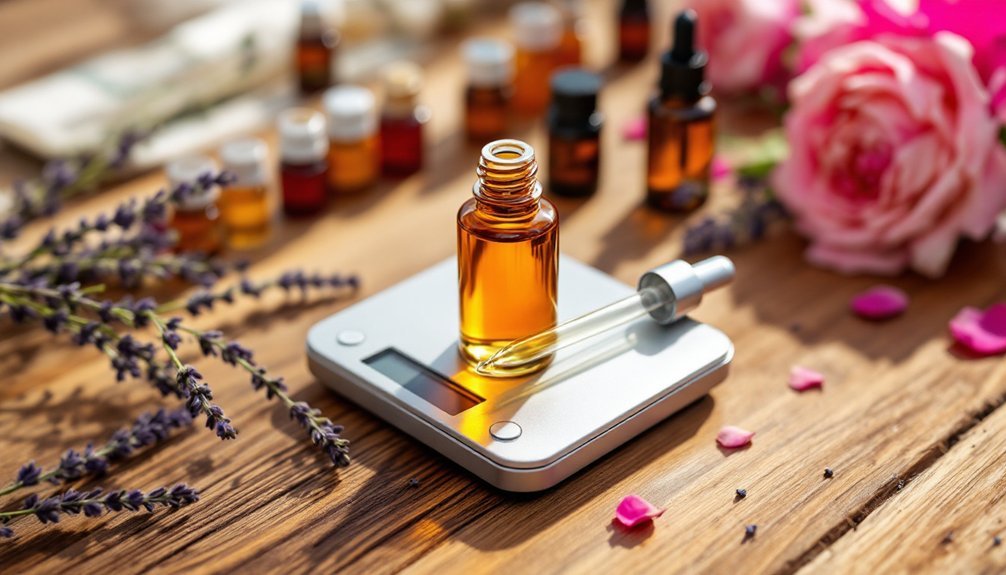


Leave a Reply